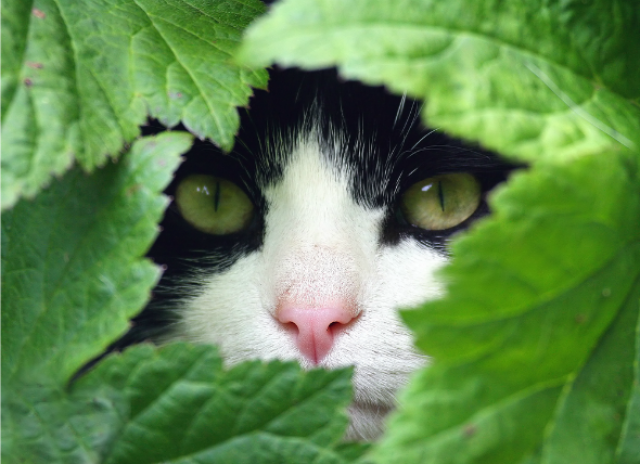
Catnip isn’t the only herb you can grow for your cat. In this article we’ll learn about 5 easy-to-grow herbs that have been traditionally used to keep cats healthy and happy. With the exception of catnip, all these herbs have medicinal properties for humans, too.
Naturally, if your cat shows signs of serious illness, you will want to seek professional help before using any medication, including one of these herbal remedies.
Catnip
Some cats are completely indifferent to catnip, while others go completely bonkers over the stuff. You can find out if your cat likes it by offering her a catnip mouse and watch how she reacts to it. Even f she tells you she would like to have a catnip plant of her own, you still might want to consider the possible problems it can create before planting one.
Some cats will travel a long distance to visit the closest catnip plant, which brings us to the most difficult part of growing this relative of common mint – protecting it from cats.
Many people bring a baby catnip plant home from the local nursery and plant it in their garden. They turn their back for just a few moments and then discover the new plant has completely disappeared. The slightly drunk kitty culprit is usually easy to find.
To protect your catnip plant, you will need to create a cage for it out of chicken wire or fencing wire. Make your cage the size that you would like the adult plant to be, and be sure to make sides and a top for the cage. Cats will chew all the leaves that grow outside the cage, and the plant will continue to put out new growth from the protected stems.
Since catnip is so attractive to cats, you can assume your neighbors’ cats will come visiting as soon as your plant is in the ground. This can be a problem if the cats stick around to dig up your garden. You should also consider whether or not you want to entice cats inside a fenced area that your dog has access to.
Even though your new plant needs careful protection, catnip can become invasive. Mints have long roots that grow near the surface of the soil, and new plants pop up along these roots. You may want to contain your catnip in a plastic container that keeps these roots from trying to take over your garden.
If you consider the problems listed above and still decide to plant some catnip, it will be one of the easiest plants you can grow. As long as you give it plenty of water and protect it from grazing cats, it will grow like a weed. Catnip is not particularly attractive, unfortunately, so you might want to hide it among some flowering annuals.
Don’t confuse the cat’s favorite herb catnip with catmint, (Nepeta)- catmint is very pretty and well worth growing in your garden, but it attracts bees and butterflies, not cats.
Calendula
Calendula, or pot marigold, is a medicinal herb, but it is most often grown for its orange, yellow, and lemon-colored flowers, which are edible. This is an annual that grows one to three feet high, and can be easily grown from seed. Be sure to start your seeds indoors about eight weeks before the last frost.
Calendula is helpful as a topical treatment for cuts and burns on your cat, and it can help reduce itching and irritation caused by flea bites and surgical incisions. You can make an ointment from the yellow petals and some olive oil. To make the ointment, crush the fresh petals with a mortar and pestle, and then add just enough olive oil to make a paste. Keep any unused ointment in the refrigerator up to 3 days.
Caraway and Dill
Caraway and dill seeds are often found in the kitchen and used for seasoning, but they also have medicinal benefits for cats. Both are biennial herbs that need full sun. Caraway will be about 2 feet tall when fully grown, while dill can reach as high as three feet. The first year your plants will only produce finely cut feathery leaves – the seeds come in the second year.
Ground-up caraway seeds can help reduce diarrhea and upset stomach in cats, but if the problem seems severe, be sure to call your cat’s vet instead of treating her yourself.
Like caraway, dill it has beautiful feathery leaves, and looks beautiful tucked into a flower garden. It is used to soothe stomach upset, nausea and flatulence caused by a change in your cat’s diet.
Echinacea
Echinacea is a perennial flowering plant that naturally grows on the American prairie. It has been shown to improve the immune system, and a poultice made of Echinacea can help reduce pain. This has also become one of our most popular garden plants because of the beautiful pink, red or white daisy-like flowers, with petals drooping around a dark center. Because of its popularity new varieties are being created every year.
Some cats have bad physical reactions to Echinacea, so use with caution. Also, cats with poor immune systems, diabetes or feline immunodeficiency virus (FIV) should never be given Echinacea without the advice of a qualified veterinarian. This is a powerful medicinal plant, and should be treated with great respect, as with any medicine.
To ease the pain from an insect bite, bruise a new leaf so some juice comes out, and place it on the sting. (This works for people, too).
As you can see from this article, there are a number of herbs that can help keep your cat healthy and happy – and most of them look great in your garden, too.
